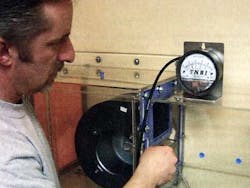Electronically Commutated Motors (ECMs) manufactured today are the best they’ve ever been and can provide unprecedented airflow delivery to match the required BTUH of a heating and/or cooling system.
There are, however, some serious downsides associated with the improper application of these motors in new and existing HVAC systems. Let’s take a candid look at the good, bad, and ugly of the application of these great gems of technology.
The Good
When a furnace or air handler with an ECM is installed on a good duct, coil, and filtration system with static pressures within proper design parameters, itAdditional benefits of these brushless DC motors include low electrical consumption when operating within design Total External Static Pressure (TESP). When installed properly, systems with ECMs can improve dehumidification, reduce register noise, save energy, and provide trouble-free operation.
The Bad
In marginal systems with higher-than-design static pressures – for example, a 0.5-in. TESP rated furnace with ECM on a 0.8-in. TESP system – the motorThe Ugly
Systems with TESPs of 1.0 and higher, which are more typical than many non-performance-based contractors are willing to admit, can eat up to eight times the power they should be using. When this happens, some ECMs will ramp down and drop airflow significantly. Some older ECM motors will overheat and even fail when constantly running in over-amped conditions. Newer models are designed to drop airflow but time will tell on how well they willOther consequences of high static installations include noise at the registers from higher air velocities. In extreme cases, filter media can be sucked out of its rack causing filter bypass. In very extreme cases filter media can be pulled into the fan, chopped up, and blown through the system causing all sorts of damage.
So, what do you measure? The first thing you should do is install test ports on either side of the blower. Once you’ve installed the test ports, use a digital or analog manometer with a static pressure tip to measure pressure at each location.
High velocities and pressures created by ECMs on systems with dirty evaporator coils can also blow moisture off the coil surfaces into the supply ductwork. This can reduce the system’s dehumidification capability and cause numerous moisture-related indoor air quality issues.
The Answer
These issues can be avoided with good pressure and airflow testing, both before and after the equipment is replaced, and on every system you service.So, what do you measure? The first thing you should do is install test ports on either side of the blower.
Once you’ve installed the test ports, use a digital or analog manometer with a static pressure tip (see diagram) to measure pressure at each location. TESP is calculated by adding the pressures before and after the fan. Other pressure readings will help you diagnose the cause of high statics – but that’s for another article.
Once you know your TESP and your fan speed setting lookup delivered fan airflow on the manufacturer’s fan table. If you’re replacing or servicing equipment with an ECM, and the TESP exceeds rated capacity, be sure to look up the motor amp draw in the manufacturer’s specifications.
Related Article: Diagnosing ECM Motors
Armed with this information you should do two things: First, alert your customer that their system has a high “blood pressure” problem that needs to be addressed. Second, diagnose the cause of the high statics and recommend solutions to bring them down to acceptable levels.
Of course, there is more to this in terms of troubleshooting and solving these issues. The bottom line is that while the ECM is a great motor, as the servicing or installing contractor it’s your responsibility to make sure its application does not cause unintended consequences detrimental to the health and well-being of your customers’ homes and HVAC systems.












